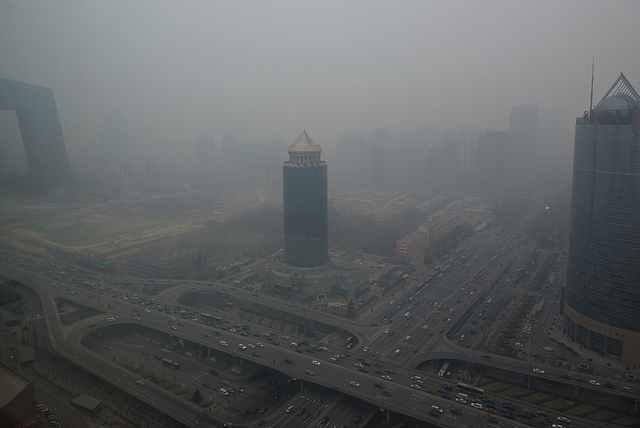It’s widely known that traffic related air pollution is associated with long-term health effects like cancers, cardiovascular or respiratory illnesses. But there’s more that could be learned about the short-term exposure to traffic-related air pollution. In the first SOCAAR Seminar for 2015-16, Marianne Hatzopoulou, Associate Professor in the Department of Civil Engineering at the University of Toronto discussed the application of transportation and emission models to investigate air pollution in the city of Montreal. The main research questions presented were: i) How can we improve measures of exposure? ii) What is the role of integrated transportation-dispersion models? Can transportation models replace atmospheric dispersion modelling? Continue reading
Tag Archives: air quality
Near-road measurement of traffic-related pollutants

Photo Source: Wikipedia user Aliamizi
Traffic related pollutants were officially classified as carcinogenic by the World Health Organization in 2013. For the many Canadians that live or work near roadways, this could be a risk factor which may negatively impact their health.
Dr. Cheol-Heon Jeong and Jon Wang, both of UofT’s Department of Chemical Engineering and Applied Chemistry, say the concentration of traffic-related pollutants varies with distance from the road; where significant pollution can be detected up to 250 metres from the road. Continue reading
Characterization of atmospheric black carbon in Toronto and the oil sands region
Human activities like burning fossil fuels and vehicle emissions generate of variety of aerosol particles like black carbon, organic, sulphate, and nitrate particles. The interaction between black carbon and other aerosol particles can change the physical and chemical properties, such as light absorption of black carbon particles. Understanding the chemical nature of these aerosol particles is important in evaluating their environmental impacts. Continue reading
Real-time characterization of soot particles
Soot particles are seen everywhere from city centres to the Alps. There’s ongoing debate on the nature and dynamic evolution of these particles in atmosphere. Soot are light-absorbing, chemically and morphologically complex particles that contribute to air pollution and can have negative health effects. Soot particles are emitted from flames and engines and are highly regional pollutants. Continue reading
Observations and impacts of aerosol acidity in North America
It’s not just the presence of aerosols but also the characteristics of the particles emissions that are related to air quality. Aerosol acidity can also have an impact in terms of human and ecosystem health. In the latest SOCAAR seminar, Dr. Jennifer Murphy, an associate professor in UofT’s Department of Chemistry, discussed the changes in the aerosol acidity from geographically diverse sites across North America.
Oil sands can produce sulphur emissions which contribute to the acidity in the atmosphere. Particle acidity is the amount of acid found in the particle phase. The deposition of acid containing particles can lead to the acidification of an ecosystem because the acidity of particles can affect the hydrophobicity of water and have climate impacts. Also, such particle absorption may influence human health.
Looking the aerosol acidity research conducting between 1990 and 2010, Murphy observes decreases in the particle emissions at various industrial, remote, and marine sites investigated in these studies. More importantly all of these sites also show significant decrease in strong acidity. She believes that this trend is likely true for the particle pH as well. Her team is currently carrying out calculations to confirm that this is the case. This trend could suggest that the gas particle partitioning behaviour and/or the particle chemistry itself is changing.
The next step of Murphy’s research will be to extend the analysis beyond just continental surface aerosol but also to aircraft field campaigns and other locations. These future studies will help determine how these values can change in different environments.
Engineering and DLSPH faculty secure internal grant to create new initiative on exposomics—the use of ‘omics to characterize environmental exposures
Many chronic diseases are now believed to be due to a combination of an individual’s genome and their cumulative environmental exposure. Exposome, analogous to genome, is an emerging approach to assessing this exposure. Internationally very large research initiatives are planned or underway in this new field but there has been little activity to date in Canada. Internal funding has just been awarded to a team lead by Prof. Greg Evans to launch an exposomics research initiative, as a multi-disciplinary collaboration between the faculty of Applied Science and Engineering and the Dalla Lana School of Public Health. This three year project will bring together and leverage existing infrastructure, expertise, and research activities across our University. The objective will be to put in place a foundation of people, methods and pilot data needed to support large research proposals and help position our University to become a leader in this exciting new research field.
HVAC filters used to investigate indoor airborne particle exposure
We spend about 90 per cent of our time indoors and airborne particles are one of the greatest indoor health risks. Research studies have shown that the majority of particles that are breathed indoors come from fine particulate matter (PM2.5). But before the air quality in residential and commercial buildings can be fully assessed, we need to first understand the composition and amount of indoor particles.
Jeffrey Siegel, an associate professor in the University of Toronto’s Department of Civil Engineering, has been investigating the use of heating, ventilation, and air conditioning (HVAC) filters as a new sampling method to detect airborne particles. In this SOCAAR seminar Siegel discusses what we can learn about human exposure to indoor contaminants from HVAC filters. Continue reading
Determining the uncertainty and variability in social costs for air quality
Scientific research is not conducted in isolation; instead, it brings together researchers in different fields as well as policymakers. Dr. Elisabeth Gilmore, Assistant Professor at the University of Maryland’s School of Public Policy, spoke about how air quality research is used in policy making to estimate the social costs of fine particulate matter (PM2.5). Continue reading
CAREBEIJING progresses air pollution control measures in Beijing

Beijing as seen through the recent smog episode. (Photo credit Flickr user: Infinite Jeff)
The severe air pollution in China’s capital, Beijing, has made the news around the world these past two months, with many wondering what was causing the smog. Professor Tong Zhu, of Peking University’s College of Environmental Sciences and Engineering in Beijing, delivered a special SOCAAR Seminar addressing the recent air pollution episode. He also highlighted steps that could be taken to improve the air quality in Beijing and the surrounding North China Plain. Continue reading
The migration of halogenated flame retardants from the indoor to outdoor environment
Halogenated flame retardants are chemical compounds containing chlorine or bromine in its chemical structure. The most commonly used flame retardants in consumer products such as electronic goods or sofas belong to the group of polybrominated diphenyl ethers (PBDEs).
The value of PBDEs in preventing fires has been questioned due to potential health concerns in humans or wildlife. Of the three forms of PBDEs used in commercial mixtures, penta and octa have already been regulated and phased out of manufacturing in North America and Europe. Currently, alternatives are being investigated to replace the deca form of PBDEs. Continue reading

